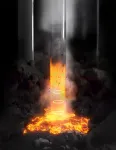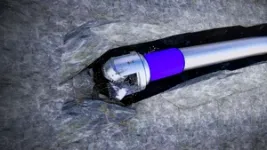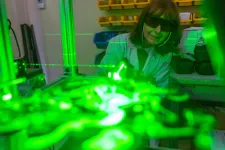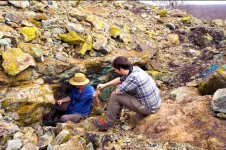(Press-News.org) CAMBRIDGE, Mass.—Clean geothermal energy—the heat beneath our feet—has the potential to be cost competitive with other renewables and even fossil fuels if we can drill deep enough to access the mother lode of the resource. That’s according to one speaker at a geothermal conference last month held by the Society of Petroleum Engineers (SPE). Other speakers addressed growing interest in the field by the oil and gas sector, key challenges it faces, and solutions to help solve those challenges.
Geothermal 2023: Realising the Ambition was organized by the Aberdeen, Scotland, section of SPE. Kirsten Pasturel, Founder and Director of ZeGen Energy and a conference organizer, noted that the event itself was a sign of increasing traction in the geothermal market, being held over two days rather than 2022’s one. Ann Robertson-Tait, President of GeothermEx, agreed, adding that one trend she’s noticed over the last year is that more oil and gas companies have started “really digging into the geothermal space.”
Why? “Arguably, the oil and gas [sector] has more relevance to geothermal than any other renewable sector. Just think about it: exploration, geoscience, wells, completions…it’s all there,” said Pasturel. “Oil and gas doesn’t have all the answers to successfully scaling geothermal, but it can undoubtedly assist with many pieces of the puzzle.”
Toward the Holy Grail
The geothermal energy stored beneath our feet exceeds our annual energy demand as a planet by a factor of a billion, said Matt Houde, a speaker at the conference and a co-founder of Quaise Energy, a geothermal startup.
Right now, however, we can’t drill deep enough to unlock the mother lode of the resource, which is some two to twelve miles beneath the Earth’s surface. There rock is so hot (temperatures are over 374 degrees C, or 704 degrees F) that if water could be pumped to the area, it would become supercritical, a steam-like phase that most people aren’t familiar with. (Familiar phases are liquid water, ice, and the vapor that makes clouds.)
Supercritical water, in turn, can carry some 5-10 times more energy than regular hot water, making it an extremely efficient energy source if it could be pumped above ground to turbines that could convert it into electricity. That could lead to “a step change improvement in terms of the power output that can be produced compared to a traditional hydrothermal well,” Houde said. “So there’s massive potential, but [accessing deep geothermal] is financially prohibitive.” Conventional drilling technologies can’t withstand the conditions miles down.
As a result, “a number of projects in the last few years have been focused on improved drilling,” said Catherine Hickson, CEO of Alberta No. 1 and a keynote speaker at the conference. “It’s the drilling costs that make geothermal a very expensive proposition if we are going for deep geothermal and higher temperatures.”
How to Get There
Several presenters at the conference addressed the drilling challenge. One session, for example, focused on oil and gas “movers” in geothermal drilling where representatives from Roemex, Adrilltech, and Expro described a variety of approaches to cut costs.
Houde, of Quaise Energy, joined Tony Pink, VP of Sub Surface Energy Technology at NOV, in a separate session titled “What’s Hot in Geothermal?” The two discussed novel drilling technologies being developed by their companies.
“Our solution at Quaise is to replace the mechanical drilling process with an energy-matter interaction that we call millimeter-wave drilling,” said Houde. Those millimeter waves, which are related to the microwaves people cook with, travel down a metallic pipe to literally melt then vaporize the rock deep below.
At the same time, the melted rock in the outer ring of the hole cools and solidifies to form a solid glass liner “that can enable borehole stability while we are drilling,” Houde said. That, in turn, could replace the more conventional steel and cement casings for that purpose, which may run into challenges at the extreme conditions deep below.
The Quaise technology also takes advantage of conventional drilling technologies. These will be used to drill down through surface layers to deep basement rock. “We then switch to millimeter-wave drilling…as we encounter diminishing returns for the conventional drilling operation,” Houde said.
Pink described NOV’s approaches to drilling deep. These include changes in the drillbit technology, such as making the diamond in the bit thicker. NOV is also looking at non-traditional technologies such as the particle impact drill. In collaboration with Particle Drilling, they are firing two-millimeter steel shot out of a bit at the rate of 12 million a minute. The shot “goes down hole, accelerates out the bit, and then comes back to the surface and is recycled,” Pink said.
Cutting costs
Houde said that the Quaise millimeter wave process is mostly independent of depth, so drilling costs are going to scale linearly with depth rather than exponentially, as happens with conventional technologies. “Combined with the power potential of superhot geothermal wells, we believe we can achieve a levelized cost of energy (LCOE) of less than $40 a megawatt hour for the most conservative cases, where we target those temperatures at a depth of 10 to 20 kilometers.”
He suggested that other factors, such as drilling to superhot temperatures at shallower depths, could get the LCOE down to below $20 or $30 per megawatt hour. At that point “it becomes incredibly competitive with the energy infrastructure today, as well as the incoming energy infrastructure—primarily wind and solar—that’s being brought online as part of the energy transition.”
Both Houde and Pink were optimistic about the future. Pink remembered how in 2006 it took 80 to 90 days to drill oil wells in the Permian Basin. They are now drilled in 15 days. “We’ve done it in unconventionals, we can do it again in geothermal.”
--END—
END
Geothermal energy has potential to be cost-competitive with other renewables and fossil fuels
Conference for oil/gas professionals addresses challenges, possible solutions
2023-03-22
ELSE PRESS RELEASES FROM THIS DATE:
Towards reducing biodiversity loss in fragmented habitats
2023-03-22
When natural habitats are cleared to make way for cities, roads and agriculture, this often leaves behind “islands” of fragmented habitat that can place species at risk of extinction. Species are at risk when they find it hard to move among habitat patches to find resources and reproduce.
By combining lab experiments and mathematical modelling, researchers at McGill University and the Swiss Federal Institute of Aquatic Science and Technology have found a way to predict the movement of species that could guide conservation efforts to reconnect fragmented habitats.
The ...
How the brain's 'internal compass' works
2023-03-22
Scientists have gained new insights into the part of the brain that gives us a sense of direction, by tracking neural activity with the latest advances in brain imaging techniques. The findings shed light on how the brain orients itself in changing environments – and even the processes that can go wrong with degenerative diseases like dementia, that leave people feeling lost and confused.
“Neuroscience research has witnessed a technology revolution in the last decade allowing us to ...
Patricia M. LoRusso, DO, Ph.D. (hc), elected as American Association for Cancer Research President-Elect for 2023-2024
2023-03-22
PHILADELPHIA – The members of the American Association for Cancer Research (AACR) have elected Patricia M. LoRusso, DO, PhD (hc), as the AACR President-Elect for 2023-2024. LoRusso will become President-Elect on Monday, April 17, during the AACR’s Annual Business Meeting of Members at the AACR Annual Meeting 2023 in Orlando, Florida. She will assume the Presidency in April 2024 at the AACR Annual Meeting in San Diego, California.
LoRusso is a professor of medicine (medical oncology); chief of experimental therapeutics; associate cancer center director for experimental therapeutics; and leader of the Phase I disease aligned research ...
Is bone health linked to brain health?
2023-03-22
EMBARGOED FOR RELEASE UNTIL 4 P.M. ET, WEDNESDAY, MARCH 22, 2023
MINNEAPOLIS – People who have low bone density may have an increased risk of developing dementia compared to people who have higher bone density, according to a study published in the March 22, 2023, online issue of Neurology®, the medical journal of the American Academy of Neurology. The study does not prove that low bone density causes dementia. It only shows an association.
“Low bone density and dementia are two conditions that commonly affect older people simultaneously, especially as bone loss often increases due to physical inactivity and poor ...
In epilepsy, higher risk of early death varies based on severity, other factors
2023-03-22
EMBARGOED FOR RELEASE UNTIL 4 P.M. ET, WEDNESDAY, MARCH 22, 2023
MINNEAPOLIS – A new study has found that people with epilepsy have an increased risk of early death and the increased risk varies depending on where they live, the number of medications they take and what other diseases they may have. The study is published in the March 22, 2023, online issue of Neurology®, the medical journal of the American Academy of Neurology.
“Our research found an increased risk even among those who do not have ...
Air flow research could reduce disease, contamination spread
2023-03-22
Air flow in a room can impact the transmission of viruses like COVID-19.
A Texas A&M AgriLife Research scientist is studying how heating, ventilation and air conditioning, HVAC, system configurations and building designs could mitigate the spread of microorganisms, including viruses, that are detrimental to human health.
Maria King, Ph.D., director of the Center for Agricultural Air Quality Engineering and Science in the Department of Biological and Agricultural Engineering, recently received a $400,000, two-year National ...
Memory B cell marker predicts long-lived antibody response to flu vaccine
2023-03-22
BIRMINGHAM, Ala. – Memory B cells play a critical role to provide long-term immunity after a vaccination or infection. In a study published in the journal Immunity, researchers describe a distinct and novel subset of memory B cells that predict long-lived antibody responses to influenza vaccination in humans.
These effector memory B cells appear to be poised for a rapid serum antibody response upon secondary challenge one year later, Anoma Nellore, M.D., Fran Lund, Ph.D., and colleagues at the University of Alabama at Birmingham and Emory University report. Evidence from transcriptional and epigenetic profiling shows that the cells in this subset differ from ...
Copper artifacts unearth new cultural connections in southern Africa
2023-03-22
COLUMBIA, Mo. – Chemical and isotopic analysis of copper artifacts from southern Africa reveals new cultural connections among people living in the region between the 5th and 20th centuries according to a University of Missouri researcher and colleagues.
People in the area between northern South Africa and the Copperbelt region in central Africa were more connected to one another than scholars previously thought, said Jay Stephens, a post-doctoral fellow in the MU Research Reactor (MURR) Archaeometry Lab.
“Over the past 20 to 30 years, most archaeologists ...
Babies or beauty?
2023-03-22
Have you ever marveled at the vast diversity of life on our planet, from tiny creatures living only a few hours to majestic beings that can survive for centuries? These differences in lifespan, size, and reproductive age are known as life-history strategies, and they have evolved over time as organisms adapt to their environments.
Evolutionary biologists have long been interested in understanding the factors that contribute to the evolution and maintenance of multiple alternative life-history strategies (ALHS) within species that lead to adaptation and novel traits. A new study published in Science Advances has not only revealed that an ALHS in Colias ...
The Protein Society announces its 2023 award winners
2023-03-22
FOR IMMEDIATE RELEASE
March 22, 2023
THE PROTEIN SOCIETY ANNOUNCES ITS 2023 AWARD RECIPIENTS
LOS ANGELES, CA – The Protein Society, the premier international society dedicated to supporting protein research, announces the winners of the 2023 Protein Society Awards, which will be conferred at the 37th Anniversary Symposium, July 13 – 16, 2023, in Boston, Massachusetts. Plenary talks from select award recipients will take place throughout the 3.5-day event. The scientific accomplishments of the awardees, highlighted here as described by their nominators, demonstrate their lasting impact on protein science.
The Carl Brändén Award, sponsored by Rigaku ...
LAST 30 PRESS RELEASES:
Tracing the quick synthesis of an industrially important catalyst
New software sheds light on cancer’s hidden genetic networks
UT Health San Antonio awarded $3 million in CPRIT grants to bolster cancer research and prevention efforts in South Texas
Third symposium spotlights global challenge of new contaminants in China’s fight against pollution
From straw to soil harmony: International team reveals how biochar supercharges carbon-smart farming
Myeloma: How AI is redrawing the map of cancer care
Manhattan E. Charurat, Ph.D., MHS invested as the Homer and Martha Gudelsky Distinguished Professor in Medicine at the University of Maryland School of Medicine
Insilico Medicine’s Pharma.AI Q4 Winter Launch Recap: Revolutionizing drug discovery with cutting-edge AI innovations, accelerating the path to pharmaceutical superintelligence
Nanoplastics have diet-dependent impacts on digestive system health
Brain neuron death occurs throughout life and increases with age, a natural human protein drug may halt neuron death in Alzheimer’s disease
SPIE and CLP announce the recipients of the 2025 Advanced Photonics Young Innovator Award
Lessons from the Caldor Fire’s Christmas Valley ‘Miracle’
Ant societies rose by trading individual protection for collective power
Research reveals how ancient viral DNA shapes early embryonic development
A molecular gatekeeper that controls protein synthesis
New ‘cloaking device’ concept to shield sensitive tech from magnetic fields
Researchers show impact of mountain building and climate change on alpine biodiversity
Study models the transition from Neanderthals to modern humans in Europe
University of Phoenix College of Doctoral Studies releases white paper on AI-driven skilling to reduce burnout and restore worker autonomy
AIs fail at the game of visual “telephone”
The levers for a sustainable food system
Potential changes in US homelessness by ending federal support for housing first programs
Vulnerability of large language models to prompt injection when providing medical advice
Researchers develop new system for high-energy-density, long-life, multi-electron transfer bromine-based flow batteries
Ending federal support for housing first programs could increase U.S. homelessness by 5% in one year, new JAMA study finds
New research uncovers molecular ‘safety switch’ shielding cancers from immune attack
Bacteria resisting viral infection can still sink carbon to ocean floor
Younger biological age may increase depression risk in older women during COVID-19
Bharat Innovates 2026 National Basecamp Showcases India’s Most Promising Deep-Tech Ventures
Here’s what determines whether your income level rises or falls
[Press-News.org] Geothermal energy has potential to be cost-competitive with other renewables and fossil fuelsConference for oil/gas professionals addresses challenges, possible solutions





